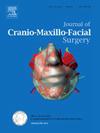揭示第三磨牙阻生与矢状分叉支截骨不良风险之间的联系:一项12年的回顾性研究。
IF 2.1
2区 医学
Q2 DENTISTRY, ORAL SURGERY & MEDICINE
引用次数: 0
摘要
不良劈裂是双侧矢状劈裂截骨术(BSSO)的已知并发症,但其发生仍不可预测。本回顾性研究探讨下颌第三磨牙的存在、嵌塞状态和解剖位置是否影响不良裂的发生率和模式。2012年至2023年间,共有819例患者接受了BSSO,包括1638个截骨部位。根据手术时第三磨牙的状态对患者进行分组。2.38%的截骨部位出现了严重的劈裂。保留第三磨牙的患者(2.65%)与至少6个月前摘除第三磨牙的患者(2.33%,p = 0.77)之间无统计学差异。同样,在严重分裂的发生与嵌塞状态(p = 0.74)或解剖位置(p = 0.33)之间没有发现显著的关联。然而,保留第三磨牙的患者经历了严重的分裂,其年龄明显增加(p = 0.004)。这些发现表明,单独的第三磨牙的结构不会增加分裂的风险,但年龄可能起一定的作用。本文章由计算机程序翻译,如有差异,请以英文原文为准。
Unveiling the link between impacted third molars and bad split risk in sagittal split ramus osteotomy: A 12-year retrospective study
Bad splits are a known complication of Bilateral Sagittal Split Osteotomy (BSSO), yet their occurrence remains unpredictable. This retrospective study investigated whether the presence, impaction status, and anatomical position of mandibular third molars affect the incidence and pattern of bad splits. A total of 819 patients who underwent BSSO between 2012 and 2023 were analyzed, encompassing 1638 osteotomy sites. Patients were grouped based on third molar status at the time of surgery. Bad splits were observed in 2.38 % of all osteotomy sites. There was no statistically significant difference between patients with retained third molars (2.65 %) and those whose third molars were removed at least six months earlier (2.33 %, p = 0.77). Similarly, no significant associations were found between bad split occurrence and impaction status (p = 0.74) or anatomical position (p = 0.33). However, patients with retained third molars who experienced bad splits were significantly older (p = 0.004). These findings suggest that the configuration of third molars alone does not increase bad split risk, but age may play a contributory role.
求助全文
通过发布文献求助,成功后即可免费获取论文全文。
去求助
来源期刊
CiteScore
5.20
自引率
22.60%
发文量
117
审稿时长
70 days
期刊介绍:
The Journal of Cranio-Maxillofacial Surgery publishes articles covering all aspects of surgery of the head, face and jaw. Specific topics covered recently have included:
• Distraction osteogenesis
• Synthetic bone substitutes
• Fibroblast growth factors
• Fetal wound healing
• Skull base surgery
• Computer-assisted surgery
• Vascularized bone grafts

 求助内容:
求助内容: 应助结果提醒方式:
应助结果提醒方式:


